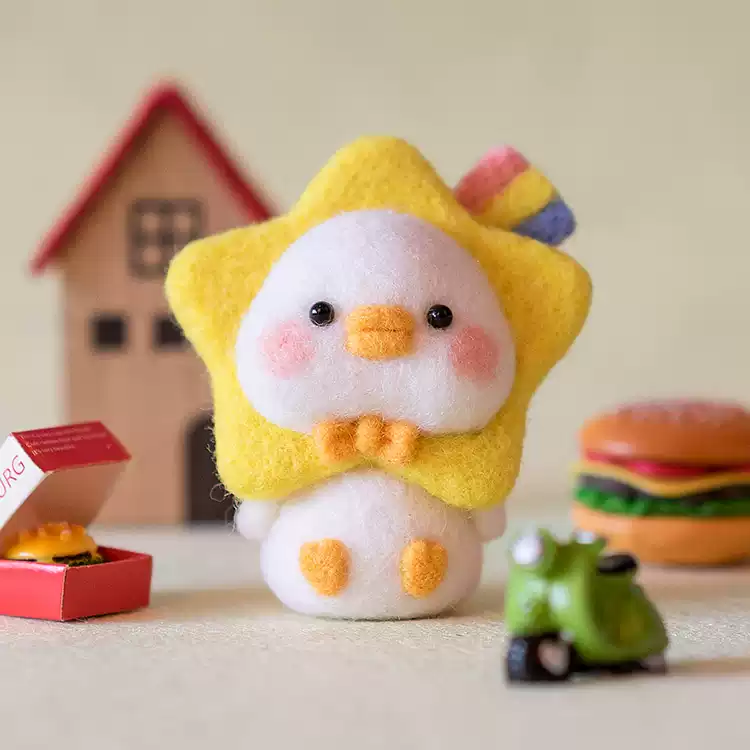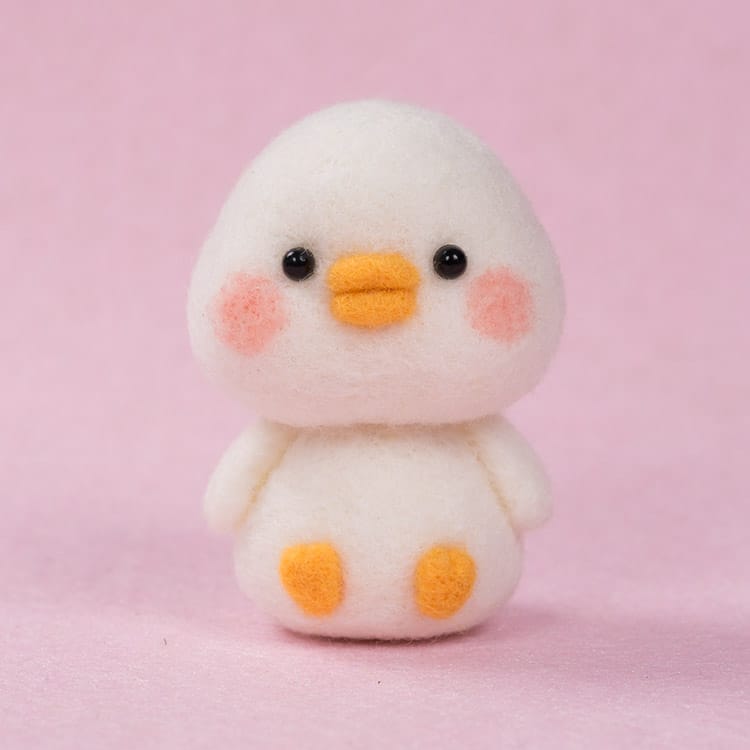
What is the Process of Felting? Needle Felting Beginner Tutorial This little duck needle felting doll is just too adorable! With its chubby body and cute little pink face, it’s truly heart-melting. As a needle felting enthusiast, I’m excited to share the step-by-step process and provide a detailed beginner’s tutorial to help you easily create this charming little duck.
If you’re also charmed by this round and adorable duck doll, you’ll be happy to know that needle felting is a simple and fun craft that only requires a special needle and some wool to create all sorts of lively and interesting shapes. This cute little duck is made using needle felting techniques, “stitched” one needle at a time.
You might wonder, “What is the process of felting?” The process of felting is like giving wool a “massage.” We use a needle with barbs (the needle felting needle) to repeatedly stab the fluffy wool. As you stab, the wool fibers interlock and tangle, similar to how yarn gets tangled when combed, gradually becoming dense and solid to form the desired shape. Isn’t that magical?
Don’t be intimidated by the complexity of needle felting—it’s actually very beginner-friendly and easy to get started. Today, let’s learn how to make this adorable little duck needle felting doll together! Follow the tutorial step by step, and you’ll be able to create your own heartwarming little duck!
Materials Needed:
- Wool Roving:
- White wool: For the duck’s body, head, and wings (arms).
- Orange wool: For the duck’s beak and feet.
- Pink wool (a small amount): For the blush on the duck’s cheeks.
- Black wool (a small amount): For the duck’s eyes (or use black beads).
- (You can choose wool colors based on your preferences, such as off-white or light yellow.)
- Needle Felting Needles:
- Coarse needle (36# or 38#): For quick shaping and handling larger wool areas.
- Fine needle (40# or higher): For detailing and smoothing the surface.
- (Beginners are recommended to purchase a set with different needle sizes.)
- Felting Mat:
- To protect your work surface, prevent needle breakage, and provide cushioning during stabbing.
- Can be made of foam, felt, or sponge.
- Black Beads or Glass Eyes (Optional):
- For the duck’s eyes.
- You can also felt the eyes with black wool for a more handmade look.
- Other Tools (Optional):
- Scissors: For trimming wool and tidying up the surface of your work.
- Glue gun or glue: For attaching bead eyes (if using beads).
- Thimble: To protect your fingers from needle pricks—highly recommended for beginners!
Step-by-Step Instructions:
Step 1: Make the Duck’s Body
- Take a piece of white wool roving and loosely roll it into an oval shape for the duck’s body.
- Place the wool on the felting mat and start stabbing it vertically with the coarse needle.
- Stab evenly in all directions to ensure the wool fibers interlock.
- As you stab, the wool will gradually become denser, smaller, and form a cylindrical shape.
- Continue shaping it into a plump, oval-cylindrical form, with a slightly flat bottom for stability.
- Stab until the wool body is firm, elastic to the touch, and has a smooth surface.
Step 2: Make the Duck’s Head
- Take a piece of white wool roving and loosely roll it into a ball shape for the duck’s head.
- Start stabbing the wool ball with the coarse needle, using the same method as for the body.
- Gradually shape it into a round, plump ball.
- The head should be slightly smaller than the body.
- Stab until the head is firm.
Step 3: Make the Duck’s Beak
- Take a small amount of orange wool roving and roll it into a thin, teardrop shape for the beak.
- Start stabbing from the thicker end of the teardrop shape, gradually tapering towards the tip.
- Shape the beak into a flat triangle or diamond shape with slightly rounded edges for a cute look.
Step 4: Make the Duck’s Cheeks
- Take a tiny amount of pink wool roving and roll it into two very small balls for the cheeks.
- Place the pink wool balls on the sides of the duck’s head, where the cheeks would be.
- Gently stab the edges of the pink wool balls with a fine needle to blend them naturally with the white wool, creating a subtle blush effect.
Step 5: Make the Duck’s Wings (Arms)
- Take a small amount of white wool roving and roll it into two short oval shapes for the wings (more like little arms).
- Use the coarse needle to stab the oval wool into a firm wing shape, with one end slightly thicker for attaching to the body.
- Make two identical wings.
Step 6: Make the Duck’s Feet
- Take a small amount of orange wool roving and roll it into two flat oval shapes for the feet.
- Use the coarse needle to stab the flat oval wool into a firm foot shape, and you can slightly shape some toes if desired (optional).
- Make two identical feet.
Step 7: Assemble the Doll
- Attach the Head to the Body:
- Place the duck’s head on top of the body and adjust the position.
- Use the coarse needle to stab along the connection between the head and body to secure them together.
- Stab from multiple angles to ensure a strong connection.
- Install the Beak:
- Place the beak in the middle-lower part of the duck’s head.
- Use a fine needle to stab the edges of the beak onto the head to secure it.
- Install the Wings (Arms):
- Place the two wings on either side of the duck’s body in the appropriate positions.
- Use a fine needle to stab the thicker end of the wings onto the body to secure them.
- Adjust the angle of the wings slightly to make the duck look more lively.
- Install the Feet:
- Place the two feet on either side of the bottom of the duck’s body.
- Use a fine needle to stab the upper edge of the feet onto the bottom of the body to secure them.
- Adjust the position of the feet to ensure the duck can stand steadily.
- Install the Eyes:
- Use a glue gun or glue to attach the black beads or glass eyes to the appropriate positions on the duck’s head.
- If you’re using black wool for the eyes, take a small amount of black wool, roll it into two small balls, and felt them onto the eye positions, shaping them with a fine needle.
Step 8: Final Adjustments and Refinements
- Check the overall shape of the doll to see if there are any areas that need adjustment, such as whether the body is plump or if the head is symmetrical.
- Use a fine needle to smooth out the surface of the doll, making it more refined, especially at the connections and detailed parts.
- Carefully trim any excess wool from the surface with scissors to make the piece look more polished.
Congratulations! Your adorable and heartwarming little duck needle felting doll is complete! Isn’t it super cute? Go ahead and place your little duck on your desk to brighten up your day!
Tips:
- Needle felting requires patience and attention to detail. Take your time and enjoy the fun of crafting.
- Beginners can refer to tutorial images or videos if they encounter problems or ask friends with experience for help.
- Always be mindful of safety while stabbing, as the needle is very sharp. Use a thimble to protect your fingers.
- Different brands and types of wool may have slightly different felting effects. Adjust the stabbing pressure and time according to the actual situation.
- The finished little duck doll can be used as a desktop ornament, a small gift, or modified into a charm, brooch, etc.
I hope this detailed tutorial helps you successfully create your adorable little duck needle felting doll. The world of needle felting is full of possibilities. Come and start your needle felting journey to create more unique pieces!
What is the Process of Felting? Needle Felting Beginner Tutorial

